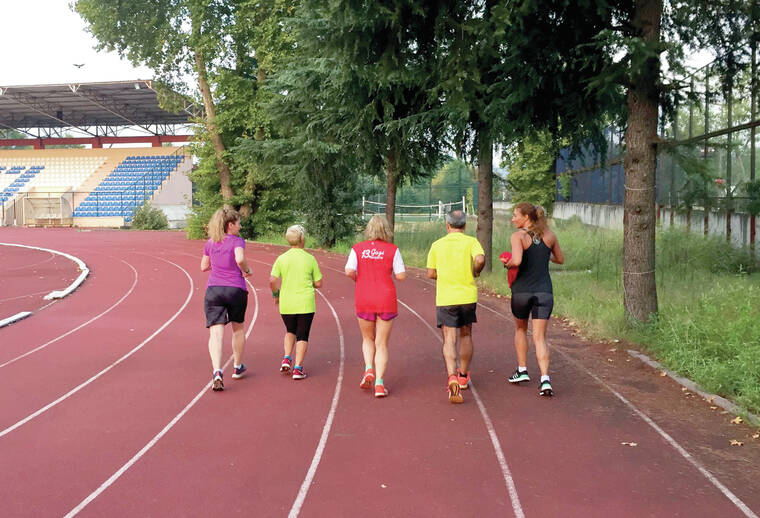A certain type of cardio has been gaining popularity for a good reason. Although we have known about it for a long time, its application is a bit more complicated than we initially thought.
You may think you’re doing enough cardio by walking, biking, or swimming, and while all of these activities are great — the training zone matters. Researchers have found that doing cardio in “Zone 2” is the most effective. Simply put, you should be able to talk clearly during your cardio session, but the person next to you should notice that you’re engaged in an activity.
In the world of endurance sports and fitness, training intensity is a critical aspect to consider. Zone 2 training has gained popularity among athletes and fitness enthusiasts, as it offers a sustainable and efficient way to improve aerobic capacity. This science-based column delves into the benefits of Zone 2 training, the physiological adaptations it promotes, and how to effectively incorporate it into your exercise routine.
During Zone 2 training the body operates at an intensity level that allows for efficient fat oxidation. The demand for energy is moderate, and the availability of oxygen is sufficient to break down fatty acids for fuel. As a result, the body can burn more fat compared to higher-intensity exercise, where carbohydrate metabolism becomes the primary energy source.
Training zones, often divided into five categories, are designed to help athletes and trainers tailor their workouts to target specific physiological adaptations. These zones are based on a percentage range of an individual’s maximum heart rate (HRmax) or, more accurately, their lactate threshold. Zone 2 training typically falls between 60 percent and 70 percent of HRmax or just below the lactate threshold.
Fat oxidation (burning) refers to the process by which the body breaks down stored fat (triglycerides) into free fatty acids and glycerol, which are then converted into adenosine triphosphate (ATP) for energy. This process predominantly occurs during aerobic exercise, such as Zone 2 training, when the body relies on oxygen to produce ATP. You can optimize fat oxidation during Zone 2 training, leading to improved endurance performance and more efficient energy utilization.
Zone 2 training is predominantly aerobic, meaning it relies on oxygen to convert stored energy (glycogen and fat) into adenosine triphosphate (ATP) — the primary energy source for cells. This process occurs in the mitochondria, often referred to as the “powerhouses” of the cells.
Training in Zone 2 stimulates the production of more mitochondria, increases capillary density, and improves the efficiency of the heart, respiratory system, and muscles in utilizing oxygen. These adaptations result in enhanced aerobic capacity, which allows us to perform longer and more efficiently at higher intensities before transitioning into anaerobic energy production.
Zone 2 training offers a multitude of benefits for athletes and fitness enthusiasts, particularly in developing aerobic efficiency and preventing injuries. By understanding the science behind this training approach and incorporating it into your routine, you can unlock the power of aerobic endurance and optimize your performance across various sports and activities.
Studies show that moderate exercise like Zone 2 also induces your cells to clear out old, malfunctioning mitochondria through a process called mitophagy. Higher-quality mitochondria have a greater capacity for fat oxidation and oxidative phosphorylation, the final stage of cellular respiration. And in addition to burning fat more efficiently and enjoyably, you can also improve aerobic efficiency, enhance recovery and blood flow, and prevent injuries.
Of course, everyone has a different fitness level, so your Zone 2 intensity (heart rate) may differ from your friend’s. It is recommended to do 60 minutes of Zone 2 training 3-4 times a week, however if you never did regular cardio exercise then you can start with 20 to 30 minutes, twice a week, and then you can increase gradually. Just listen your heart.
Resources:
• Exercise and mitochondrial health. The Journal of Physiology. https://physoc.onlinelibrary.wiley.com/doi/10.1113/JP278853
• Heart Rate Acquisition and Threshold-Based Training Increases Oxygen Uptake at Metabolic Threshold in Triathletes: A Pilot Study. National Library of Medicine. https://www.ncbi.nlm.nih.gov/pmc/articles/PMC6355121/
•••
Ayda Ersoy is a nutritionist (Dip.C.N., Dip.S.N.); master trainer (CPT ACE, NCSF, CanfitPro); registered yoga teacher; founder, Health Angel Nutrition, Fitness and Wellness; and founder, SMS (Stability, Mobility Strength) Intuitive Training System.


